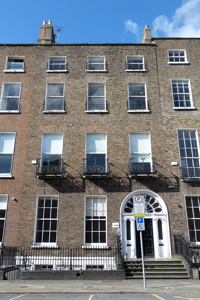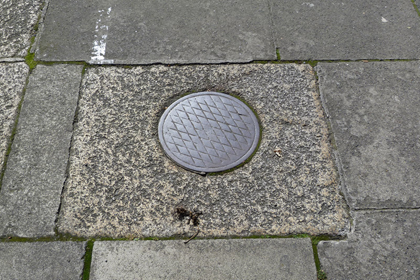Survey Data
Reg No
50100419
Rating
Regional
Categories of Special Interest
Architectural, Artistic
Original Use
House
In Use As
Office
Date
1785 - 1795
Coordinates
316626, 233465
Date Recorded
03/07/2016
Date Updated
--/--/--
Description
Attached three-bay four-storey house over basement, built c. 1790 apparently as one in terrace of seventeen, having bow to two eastern bays at rear, and four-bay two-storey return to third bay with further storey to north end. Now in use as offices. Pitched slate roof to front, behind brick parapet with granite coping, and two hipped roofs to rear perpendicular to street, larger over bow. Shouldered rendered chimneystacks with clay pots. Flemish bond red brick walls with painted granite plinth course over painted rendered walls to basement. Square-headed window openings, diminishing in height to upper floors, with raised rendered reveals and painted granite sills; carved granite block-and-start surrounds and wrought-iron grilles to basement. Timber sliding sash windows, front elevation having six-over-six pane to ground floor and basement and replacement one-over-one pane elsewhere; and rear elevation having tripartite windows, three-over-three-pane to top floor and six-over-six pane to lower floors. Decorative cast-iron balconettes to first floor and wrought-iron window-guards to top two floors. Round-headed principal doorway with rendered linings, fluted frieze and cornice, engaged Ionic columns with respond pilasters framing stained-glass sidelights, elaborate petal fanlight with projecting lantern, and eleven-panel timber door with brass furniture. Granite platform with cast-iron boot-scrape and five bull-nosed granite steps. Wrought-iron railings to basement area with decorative cast-iron posts on carved granite plinth. Cast-iron coal-hole covers set in granite flags to footpath. Garden and carparking to rear, and recent two-storey building on site of former mews house to Fitzwilliam Lane.
Appraisal
No. 69 Merrion Square is an elegant Georgian house that forms part of the eighteenth-century square developed by the Fitzwilliam Estate. Its decorative focus is a fine Ionic doorcase, that together with decorative iron balconettes to its first floor and more modest window-guards above provides good detailing and craft interest to the otherwise restrained façade. The fanlight to the entrance also features a rare early lantern. The building and its intact setting details contribute significantly to the intact appearance of this important architectural set-piece. The square is one of the best-preserved Georgian streetscapes in Ireland. The north, east and south sides are lined with terraced houses of eighteenth and early nineteenth-century date, while the west side is terminated by the garden front of Leinster House and the flanking Natural History Museum and National Gallery. The houses maintain a relatively uniform building height and design, attributed to standards promoted in Fitzwilliam's leases. Individuality was introduced through the design of doorcases, window ironwork and interior decorative schemes. The south side of the square was initially set in large plots of twelve leases; plots were leased consecutively from east to west up until the row was completed in 1791.























